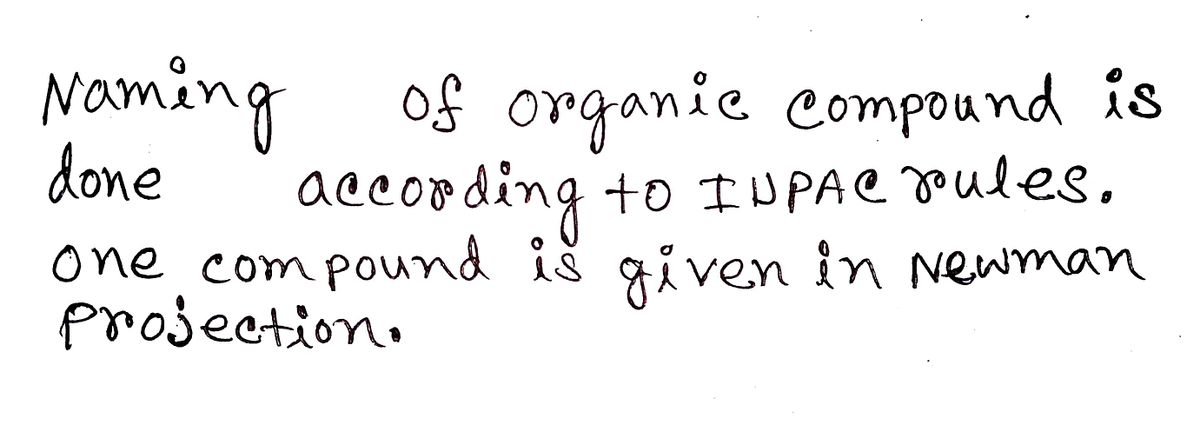Chemistry
10th Edition
ISBN:9781305957404
Author:Steven S. Zumdahl, Susan A. Zumdahl, Donald J. DeCoste
Publisher:Steven S. Zumdahl, Susan A. Zumdahl, Donald J. DeCoste
Chapter1: Chemical Foundations
Section: Chapter Questions
Problem 1RQ: Define and explain the differences between the following terms. a. law and theory b. theory and...
Related questions
Question

Transcribed Image Text:**Title: Understanding IUPAC Nomenclature for Organic Compounds**
**What is the IUPAC Name?**
*Diagram Description:*
The diagram illustrates a Newman projection, a type of molecular representation used to show conformation in organic molecules. It displays a central circle with lines radiating out to denote carbon bonds. The central point represents the front carbon atom, while the circle represents the back carbon atom.
- **Upper left bond**: Attached to the front carbon, marked with a methyl group (CH₃).
- **Upper bond**: Attached to the back carbon, marked with a propyl group (CH₂CH₂CH₂CH₃).
- **Upper right bond**: Attached to the back carbon, labeled with hydrogen (H).
- **Lower left bond**: Attached to the back carbon, labeled with hydrogen (H).
- **Lower right bond**: Attached to the front carbon, marked with a butyl group (CH₂CH₂CH₂CH₃).
*Objective of the Diagram:*
The purpose of this diagram is to determine the IUPAC (International Union of Pure and Applied Chemistry) name of the molecule based on the displayed conformation. IUPAC names are systematic names used for identifying chemical components. This representation helps visualize the three-dimensional orientation of atoms in different conformations, important for understanding the compound's chemical behavior and properties.
Expert Solution
Step 1: Introduction to Nomenclature

Step by step
Solved in 4 steps with 4 images

Knowledge Booster
Learn more about
Need a deep-dive on the concept behind this application? Look no further. Learn more about this topic, chemistry and related others by exploring similar questions and additional content below.Recommended textbooks for you

Chemistry
Chemistry
ISBN:
9781305957404
Author:
Steven S. Zumdahl, Susan A. Zumdahl, Donald J. DeCoste
Publisher:
Cengage Learning

Chemistry
Chemistry
ISBN:
9781259911156
Author:
Raymond Chang Dr., Jason Overby Professor
Publisher:
McGraw-Hill Education

Principles of Instrumental Analysis
Chemistry
ISBN:
9781305577213
Author:
Douglas A. Skoog, F. James Holler, Stanley R. Crouch
Publisher:
Cengage Learning

Chemistry
Chemistry
ISBN:
9781305957404
Author:
Steven S. Zumdahl, Susan A. Zumdahl, Donald J. DeCoste
Publisher:
Cengage Learning

Chemistry
Chemistry
ISBN:
9781259911156
Author:
Raymond Chang Dr., Jason Overby Professor
Publisher:
McGraw-Hill Education

Principles of Instrumental Analysis
Chemistry
ISBN:
9781305577213
Author:
Douglas A. Skoog, F. James Holler, Stanley R. Crouch
Publisher:
Cengage Learning

Organic Chemistry
Chemistry
ISBN:
9780078021558
Author:
Janice Gorzynski Smith Dr.
Publisher:
McGraw-Hill Education

Chemistry: Principles and Reactions
Chemistry
ISBN:
9781305079373
Author:
William L. Masterton, Cecile N. Hurley
Publisher:
Cengage Learning

Elementary Principles of Chemical Processes, Bind…
Chemistry
ISBN:
9781118431221
Author:
Richard M. Felder, Ronald W. Rousseau, Lisa G. Bullard
Publisher:
WILEY